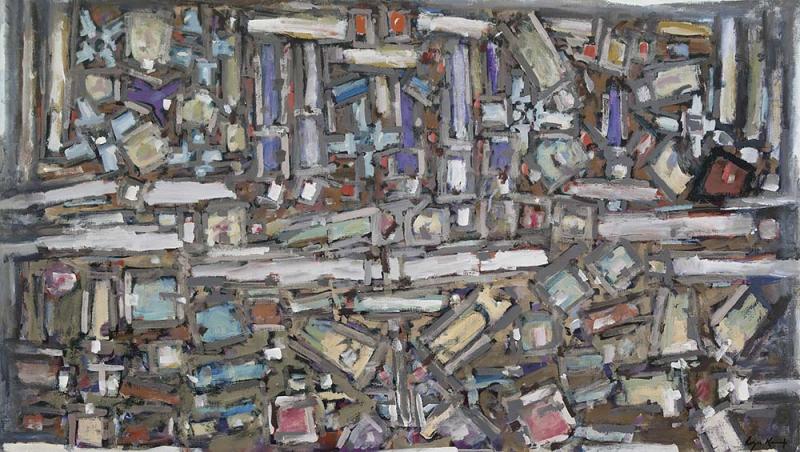ROGER KEMP (1908-1987)
Horizontal Sequence c1970
Estimate: $50000 - 60000
Sold For:
$48000 hammer
Description
ROGER KEMP (1908-1987)
Horizontal Sequence c1970
synthetic polymer paint on canvas
152.0 x 239.0 cm
signed lower right: Roger Kemp
Provenance:
Realities Gallery, Melbourne
Private colection, Melbourne
Exhibited:
Realities Gallery, Melourne, 13 - 30 June 1973, cat.4
Reference:
Heathcote, C., A Quest for Enlightenment - The Art of Roger Kemp, Macmillan, Melbourne, 2007, p.259, no.14.4
Estimate: $50000 - 60000
Result Hammer: $48000
Roger Kemp’s Horizontal Sequence of circa 1970 has hung in the present owners’ Melbourne home for forty-one years. That is, since 1973 - the year that the painting was purchased from the Realities Gallery in Toorak at its first and only exhibition.
This large painting has a commanding pictorial presence that is visually balanced by the use of a subtle tonal range. These complementary mural-like attributes make the painting seem to conjoin with a wall surface in ways that may be seen and sensed in the best abstract art works. This visual ‘flatness’ is used as an aesthetic device that makes the painting seem to rest on a wall rather than hang from it – for example, as may be seen in the tapestries based on Kemp’s paintings in the Great Hall of the National Gallery of Victoria. This lends Horizontal Sequence of c1970 a quiet painterly pulse that heightens its atmospheric effects in a domestic setting.
Like Jackson Pollock’s magisterial Lavender Mist of 1950 in the National Gallery of Art in Washington, Kemp’s painting gains from a up-close-walk-by scanning of its harmonised colours and patterned surfaces – only then does its visually bonded molecularity come to the fore. Painting such as this cannot be ‘read’, only responded to and ‘taken in’.
Of course, one might legitimately ask what the artist responded to and ‘took in’. In Pollock’s case, it was dawn’s drizzly reflections on New York’s East River; in Kemp’s, perhaps the gliding soft tones of a river stream or the blurred busyness of passing car lights semi-prismatically reflected on or through a wet car window. Whatever the case, in each artist’s procedure there exists the attempt to distil a felt experience that has been conveyed by an intermediary visual event. This is Kemp’s view of abstraction.
In many ways Kemp’s body of painting may be usefully compared with music. There are passages, movements, compositions, symphonies, concertos and small notations – music heard that remains incomplete. Likewise, music does not ask to be ‘read’ as a story or be considered as an exact reflection of Nature – rather it exists in and of itself as an ‘abstraction’, a ‘creation’ or as a mode of expression that starts somewhere and goes somewhere else. As it goes it weaves its own hitherto unknown reality.
So it is with the art of Roger Kemp (OBE, AO). Little wonder that he thought of his own improvised abstraction as a type of ‘cadenza’ upon a theme1. Speaking within the context of American Abstract Expressionism, the art historian and critic Christopher Heathcote writes:
… Kemp did not attach the same social significance to improvisation (as Abstract Expressionism). It was, for him, what one did to make work that was original and fresh, unlike the academic approach he had learned at art school, which resulted in painting that was rehearsed and dull. In our many conversations during the 1970s and 80s Roger Kemp spoke of improvisation as something close to a cadenza in classical music, that is, a moment for a virtuoso display of free composition within the melodic terms set by the greater opus. Indeed, he disliked the approach of more commercially-oriented classical and jazz soloists – who strung prepared licks and phrasings in appropriate combinations – insist that the elements of the composition should be untainted by a sense of routine2.
The art collector and patron Marianne Baillieu selected Kemp’s Horizontal Sequence of circa 1970 for his Realities Gallery solo exhibition of the same year. The painting sat firmly amongst fourteen others as a strikingly realised example of his early Seventies exploration of abstraction – its combination of painterly verve, impasto technique and subtle visual balance were noted and reviewed by the critics Bernard Boles, Maureen Gilchrist, Jeffrey Makin, Alan McCulloch, Michael Shannon and Patrick McCaughey. Kemp’s work was abstract because, he said, all the really important things are abstract.
Footnotes:
1. I owe this incisive insight to Dr Christopher Heathcote. See his A Quest for Enlightenment-The Art of Roger Kemp, Macmillan, Melbourne, 2007, p.152, footnote 300.
2. ibid.
Literature:
Allen, C., Art in Australia: From Colonisation to Postmodernism, Thames & Hudson, London, 1997.
Catalano, G., The Years of Hope: Australian Art and Criticism 1956-68, Oxford University Press, Melbourne, 1981
Smith, B.; Smith, T.; Heathcote, C., Australian Painting, 1788-2000, Oxford University Press, South Melbourne, 2001
Heathcote, C., A Quest for Enlightenment-The Art of Roger Kemp, Macmillan, Melbourne, 2007.
Heathcote, C., A Quiet Revolution: The Rise of Australian Art 1946-68, Text Publishing, Melbourne, 1995.
McCaughey, P., Roger Kemp: Cycles and Directions 1935-1975, Monash University Gallery, Melbourne, 1978
McCaughey, P., ‘Roger Kemp’, Art & Australia, vol.8, no.2, 1970
Associate Professor Ken Wach
Dip. Art; T.T.T.C.; Fellowship RMIT; MA; PhD.
Emeritus Principal Research Fellow and Head, School of Creative Arts
The University of Melbourne.
Location
SYDNEY VIEWING. 6 - 9 March 11am - 6pm. 12 Todman Avenue, Kensington
MELBOURNE VIEWING. 13 - 19 March 11am - 6pm. Stonington Mansion, 336 Glenferrie Rd, Malvern
